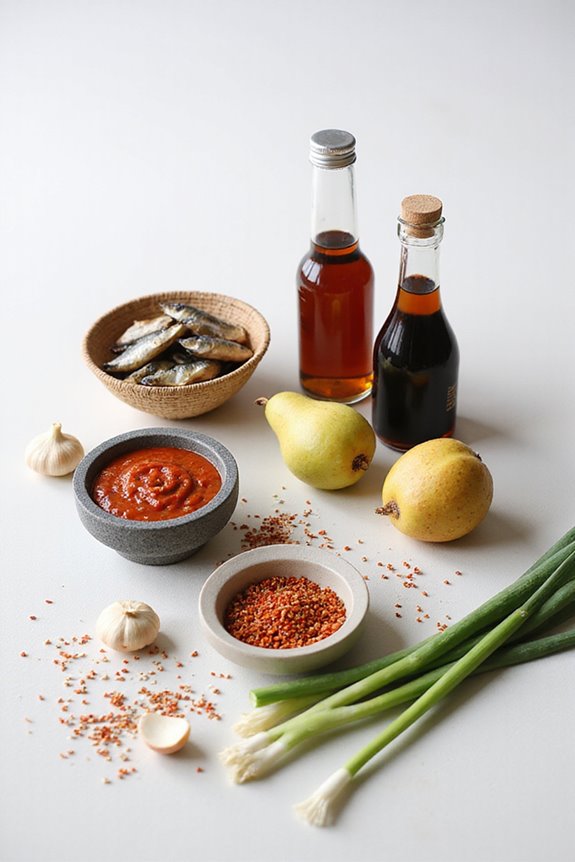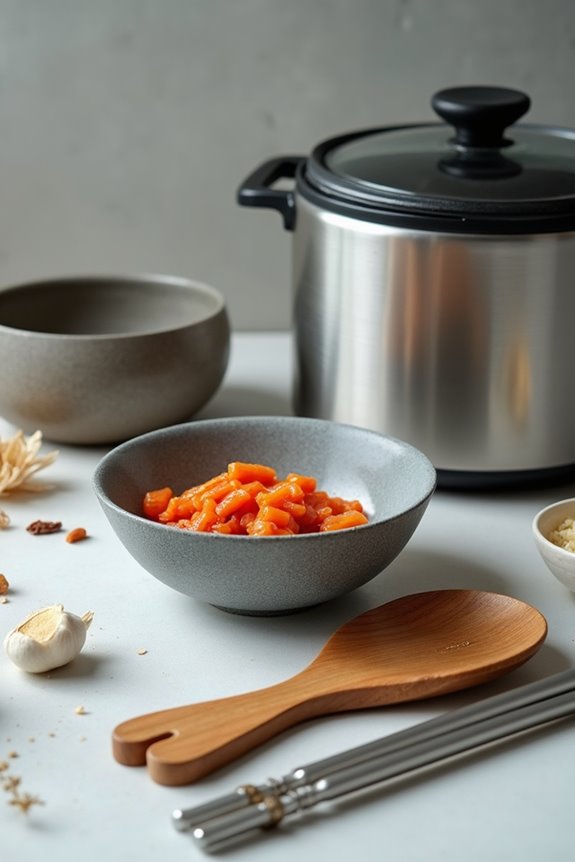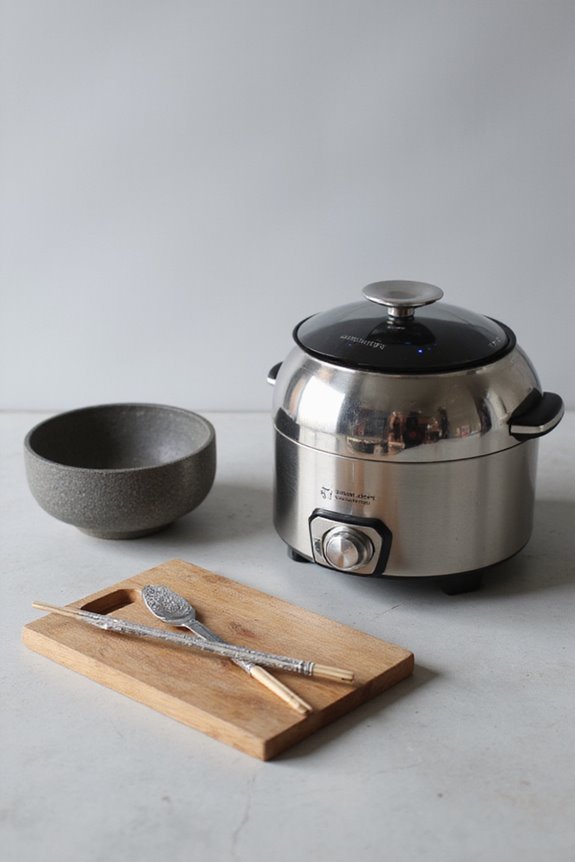To cook Korean food, we start by understanding essential ingredients like ganjang (soy sauce) and gochujang (red chili paste). We incorporate techniques such as fermentation for flavor and nutrition, using staples like kimchi. Mastering cutting techniques guarantees we achieve even cooking in our dishes. Marination enhances flavors and tenderizes proteins, while balancing sweet, savory, and spicy elements is key. With these foundations, we can explore common dishes and their unique flavor profiles, leading to a rewarding culinary experience.
Key Takeaways
- Familiarize yourself with essential ingredients like ganjang, doenjang, gochujang, scallions, and garlic for authentic flavor profiles in dishes.
- Utilize fermentation techniques to enhance flavor and nutrition, especially with staples like kimchi and fermented sauces.
- Master cutting techniques and marination methods to improve texture and introduce rich tastes to your meals.
- Incorporate a balanced mix of flavors—sweet, savory, spicy, sour, and umami—for a well-rounded culinary experience.
- Embrace communal dining practices, sharing multiple dishes, and appreciating food as a way to foster connections and hospitality.
Understanding Basic Ingredients
When we explore Korean cuisine, understanding the basic ingredients is essential for capturing the authentic flavors that define this vibrant culinary tradition. Essential pantry staples like ganjang and doenjang bring depth to various dishes, while gochujang offers a unique sweet heat that enhances flavor combinations. The ingredient pairings of scallions and garlic serve as foundational seasonings, adding robustness to soups and sauces. Common proteins, such as pork belly and dried anchovy, provide distinct umami notes in stews and stocks. Incorporating vegetables like radish and leafy greens further enriches the cuisine, contributing both taste and texture. By mastering these key ingredients, we can create delicious Korean dishes that reflect the culture’s love for bold, balanced flavors. Additionally, using high-quality sauces can significantly elevate the flavors and authenticity of your cooking experience.
The Importance of Fermentation
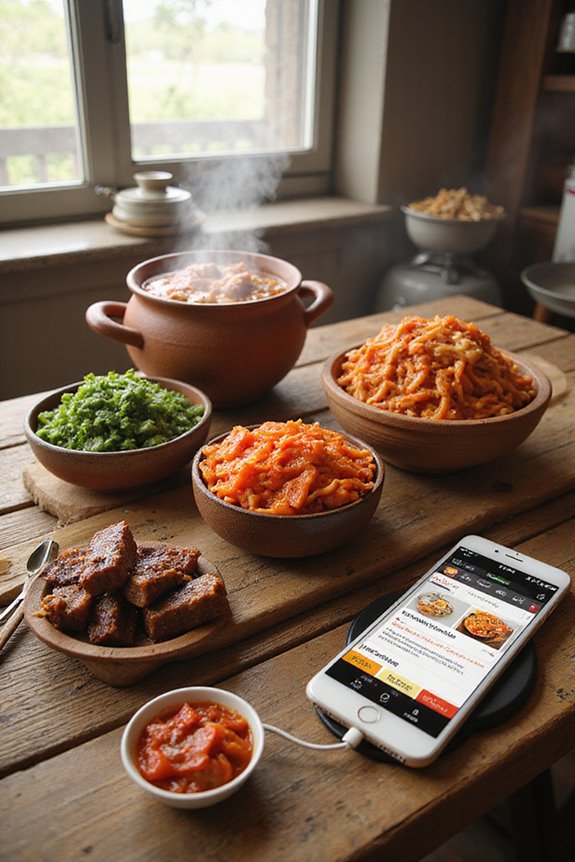
Fermentation plays a fundamental role in Korean cuisine, elevating both flavor and nutrition in numerous dishes. By employing traditional techniques, we harness the power of microbial diversity, fostering unique flavor development in each family’s recipes. For example, the intricate process of making *doenjang* and *ganjang* showcases how wild bacteria like *Bacillus subtilis* contribute essential flavors and health benefits. Fermented foods also enhance nutrient bioavailability, allowing us to enjoy increased amino acids and vitamins. Additionally, the consumption of these foods supports our digestive health due to their probiotic content. Ultimately, fermentation maintains our cultural heritage, connecting generations through shared culinary practices, while offering multifaceted health impacts that enrich our diets and overall well-being.
Essential Cutting Techniques
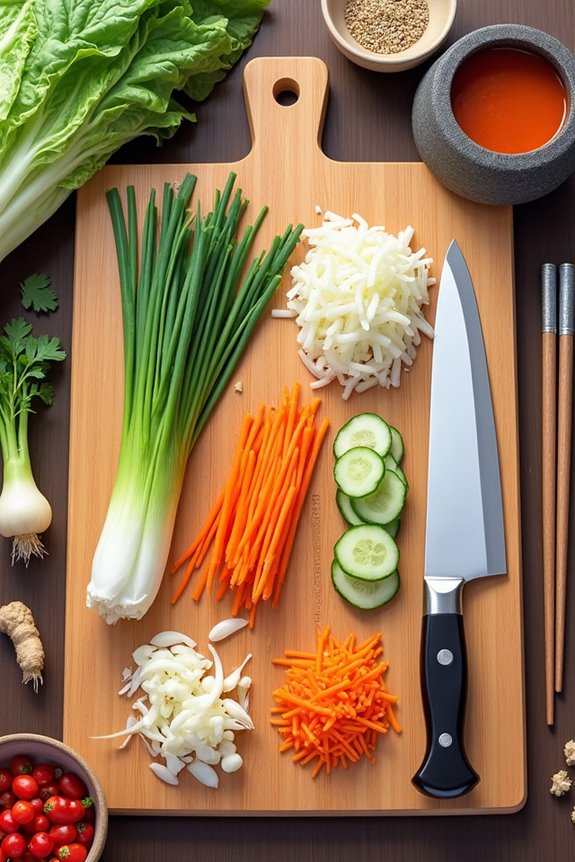
Mastering essential cutting techniques is crucial in Korean cuisine, as they not only enhance the cooking process but also guarantee each dish reaches its intended flavor and texture. Effective knife techniques are fundamental for ingredient preparation; they range from slicing vegetables to mincing garlic. For instance, daepa, or Welsh onion, requires precise cuts to release its flavor and complement various dishes. Using specialized knives can improve control and ensure safety; we should always keep our fingers tucked while cutting. Techniques like chopping or rotational chopping can achieve uniform sizes, which is important for even cooking. By consistently practicing these cutting skills and understanding ingredient textures, we enhance the quality and presentation of our Korean meals.
Balancing Flavors in Korean Cuisine
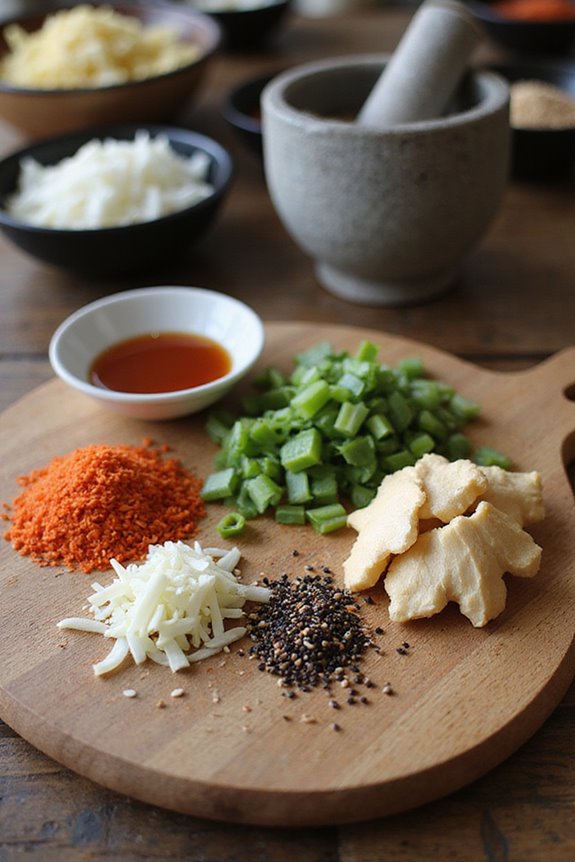
Balancing flavors in Korean cuisine is essential not only for taste but also for creating harmony in every meal we prepare. The five fundamental flavors—sweetness, sourness, bitterness, saltiness, and spiciness—each contribute to our meals’ vibrant taste profile. Achieving effective flavor balancing involves mixing these elements with dishes, such as pairing rich pork belly with invigorating cabbage kimchi. Key condiments like doenjang, ganjang, and gochujang introduce complexity and umami; however, they can overpower if not balanced with milder ingredients. We also utilize diverse textures and colors in our dishes, which enhances the overall sensory experience. When we include assorted banchan, we’re able to customize our flavor profiles, allowing each bite to encompass a harmonious blend of tastes. Additionally, incorporating authentic Korean ingredients can enrich the depth of flavors and elevate your cooking experience.
Mastering Marination
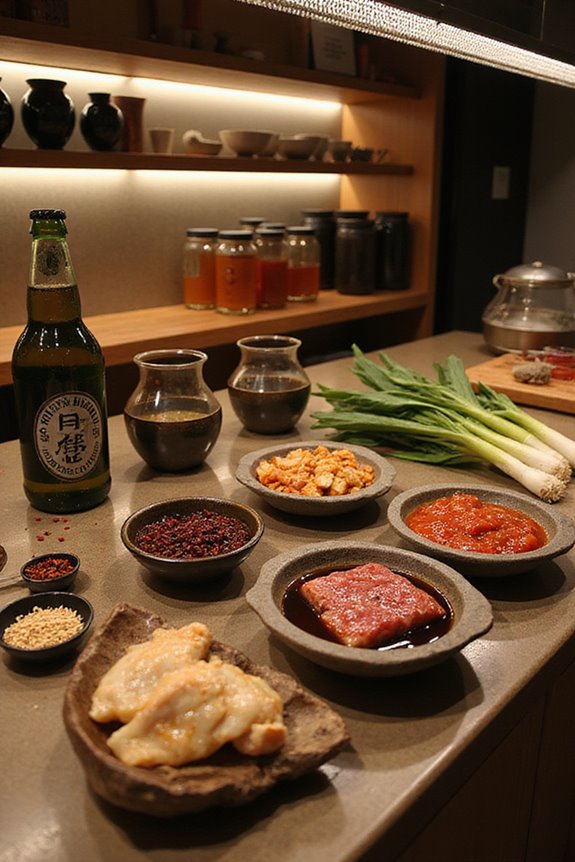
One of the key aspects of cooking Korean food is the technique of marination, which greatly enhances flavors and textures. By exploring various marinade variations, we can personalize our dishes. Essential ingredients like soy sauce, gochujang, garlic, and ginger create a robust foundation for marinades suitable for proteins such as beef, chicken, seafood, and tofu. The marination benefits include tenderizing meat and infusing it with rich flavors. For instance, marinating beef for up to 4 hours with a bulgogi marinade and massaging it in boosts absorption. We should remember to refrigerate during marination to guarantee safety. Taking these steps allows us to elevate our Korean cooking, ensuring every bite is flavorful and satisfying. Additionally, using all-natural ingredients in your marinades can significantly enhance the authenticity of the flavors.
Traditional Cooking Methods
Understanding the various traditional cooking methods is essential for authentically preparing Korean cuisine. Boiling techniques, fundamental in our cooking, infuse depth into soups and stews, such as doenjang-guk and jjigae. Grilling methods, particularly over charcoal, create beloved dishes like bulgogi, enhancing flavor through caramelization and smoke. Steaming practices, like preparing jjim, retain moisture in proteins and vegetables while preserving essential nutrients. While smoking techniques are less prevalent, they offer unique flavors, especially for certain meats and fish. Each method not only reflects our culinary heritage but also demonstrates the importance of technique in achieving specific textures and tastes, ensuring that our traditional recipes stand the test of time and deliver authentic Korean flavor profiles.
Exploring Common Korean Dishes
When we investigate exploring common Korean dishes, we discover a rich tapestry of flavors and textures that define our culinary tradition. One staple is kimchi, a fermented side dish made primarily from napa cabbage or radishes, known for its spicy and sour notes. Bibimbap, a vibrant mixed rice bowl topped with vegetables and often a fried egg, showcases the country’s commitment to balance and nutrition. Korean-style fried chicken, recognized globally, boasts a crispy exterior and unique seasonings. Additionally, bulgogi, marinated beef cooked to a sweet-savory perfection, offers a delightful taste experience. On Korean streets, popular snacks like tteokbokki—a spicy rice cake dish—capture the attention of locals and tourists alike, enhancing the overall appreciation for Korean cuisine. Cooking these dishes at home can be enhanced by using an indoor electric grill, which provides efficient cooking and reduces smoke, making it ideal for indoor use.
Essential Cooking Tools
In Korean cuisine, having the right tools can greatly enhance our cooking experience and the quality of our dishes. A rice cooker offers numerous benefits, providing consistent rice and keeping it warm, while modern options include settings for porridge and steaming. The advantages of a ttukbaegi are significant, allowing for perfect stews and soups, retaining heat for communal dining. Cast iron pots demonstrate incredible versatility for Korean dishes, like budae jjigae, benefiting from even heat distribution. For preparation, a mandoline enhances safety and uniform slicing of vegetables, and a food processor boosts efficiency by speeding up chopping tasks. Finally, utensil essentials such as long cooking chopsticks and kitchen scissors further streamline our cooking processes, enhancing overall effectiveness. Additionally, using a bamboo steamer can promote healthier cooking by preserving the flavor and nutrition of your dishes.
Flavor Profiles and Seasonings
Korean cuisine offers a remarkable array of flavors, characterized by a balance among five key tastes: sweet, savory, spicy, sour, and umami. We often utilize various seasoning varieties, such as gochujang and doenjang, which help create rich flavor combinations and umami layers in our dishes. The spice intensity can vary, influenced by regional differences and personal preferences. We source ingredients carefully, ensuring the freshest aromatic herbs and spices, like ginger and garlic, enhance our meals. Taste balancing is essential, incorporating sweet elements like honey alongside salty components. Fermented seasonings, particularly kimchi, contribute to the complexity of Korean flavors. Proper use of these techniques elevates our cooking, allowing us to create satisfying and flavorful dishes.
Cultural Practices Surrounding Korean Meals
Cultural practices surrounding meals reflect the values and customs intrinsic to the dining experience. Meal etiquette in Korea emphasizes elder respect; the oldest individual always starts eating first. This practice sets the tone for communal dining, where we typically share multiple dishes from central plates. Conversation norms dictate polite interactions, encouraging engagement while avoiding controversial topics. We often use polite phrases, such as “Jal-mukkes-seub-nida,” before eating, expressing appreciation for the meal. Utensil hygiene is essential; we refrain from licking utensils or using dirty hands. Additionally, posture manners, like sitting upright and not reaching across the table, are expected. By adhering to these sharing customs, we honor food appreciation and foster meaningful social interaction during meals.
Frequently Asked Questions
What Are Common Mistakes to Avoid When Cooking Korean Food?
When we cook Korean food, we should avoid common mistakes like improper ingredient substitutions and poor cooking techniques. Preheating pans and slicing ingredients correctly guarantees balanced flavors and textures, elevating our culinary experience.
How Can I Adjust Spice Levels in Korean Recipes?
To adjust spice levels in our recipes, we can explore spice alternatives and focus on flavor balancing. By gradually adding mild ingredients like sugar or dairy, we’ll create a more pleasant heat that suits everyone.
Where Can I Find Authentic Korean Ingredients?
We can find authentic Korean ingredients at local Korean markets or online retailers like Amazon. These sources provide everything from gochugaru to doenjang, making it easy for us to enjoy authentic flavors in our cooking.
How Do I Store Leftover Korean Dishes Properly?
As we imagine our cozy kitchen filled with savory aromas, let’s remember proper leftover storage for meal prep. Airtight containers and freezer bags keep our delicious Korean dishes fresh, so we can savor them later!
Are There Vegetarian Options for Traditional Korean Dishes?
Absolutely, we can explore Korean vegetarian options! Many traditional adaptations exist, like bibimbap and japchae, which can be easily modified to exclude meat and fish, allowing us to enjoy authentic flavors without compromising our dietary choices.


